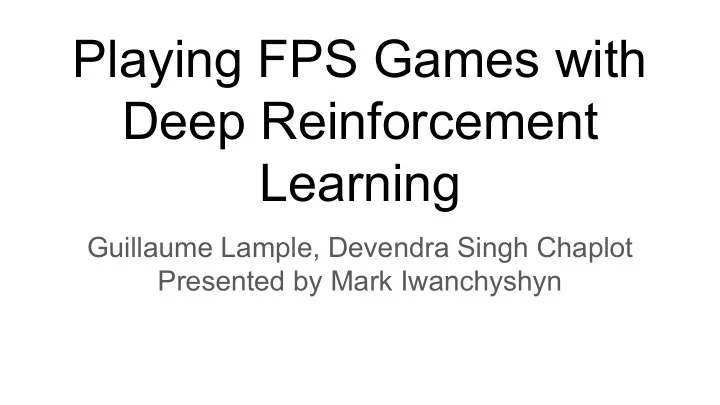

Playing FPS Games with Deep Reinforcement Learning Guillaume Lample, Devendra Singh Chaplot Presented by Mark Iwanchyshyn
Introduction
Doom, the video game Make an agent that can play deathmatch games in Doom The input is the 60x108 colour screen The agents actions are: turn {left, right}, walk forward, shoot, etc, (a subset of what the game provides)
Doom Details The game is early 3D and automatically compensates for aiming differences in elevation. So only left and right are necessary. In the ‘deathmatch’ game each agent tries to maximise their number of kills vs their number of deaths. The agent can pick up health or ammunition throughout the level.
Proposed Agent (Simplified) A deep neural network that is a Long Short Term Memory cell on top of a Convolutional Neural Net. The intuition is that the CNN can process the raw image data and produce some higher level information that the LSTM can do something with.
The Proposed Solution
Deep Recurrent Q Networks (DRQN) Instead of estimating Q(o t , a t ), we want Q(o t , h t-1 , a t ). Where h t-1 is some other output of our function at the previous timestep. This is implemented as: h t = LSTM(h t-1 , o t ) We estimate our Q as Q(h t , a t )
Network Structure
Notes on Network Structure Layer 3’ is layer 3 flattened Each convolution has a third input dimension that is the number of feature maps in the previous layer The size of the LSTM hidden state is never specified The entire structure seems to be strongly based on their citation of Hausknecht and Stone (2015): https://arxiv.org/abs/1507.06527 This source also talks about screen flicker in games which was covered in this course.
Game feature augmentation To improve training the network is not only trained reinforcement-wise using the reward function. During training the network is also trained to extract features about the world that their game engine provides: is there an enemy on the screen? Am I out of ammunition? These are the size-k game features in the network. This way the CNN is jointly trained, and the authors theorise this helps it extract information about the current frame.
Navigation Network Two separately trained networks were used for the agent. Identical structure, but the navigation network could only move. Swapping between the Navigation network and Action network was determined by the presence of enemies on the screen, an output that was trained from a game feature. This network was easier to train and encouraged searching for health and ammo instead of ‘camping’.
Training Reward shaping: Positive for picking up items, negative for losing health, negative for shooting, positive for distance traveled since last step (prevents turning in circles) The navigation network was at times trained on a map without enemies just so it would learn to efficiently pick up items. Frame skip: only each k th frame is considered and the action decided is repeated (equivalent to key held down) for the next k frames. In the paper they decide on considering every 5 th frame.
Training Details Used RMSProp algorithm Replay memory of 1 million most recent frames Minibatch size of 32 Epsilon greedy starting at 1 going to 0.1 over the first million frames Discount factor of 0.99 Only experiences with enough history are backpropagated
Evaluation
Scenarios Limited deathmatch on a known map Full deathmatch on unknown maps Only weapon is rocket launcher that all agents All agents start with pistol and must pick up start with other weapons Single known map 10 maps for training, 3 maps for testing
Opponents The opponents used in this paper were mostly the built-in doom ‘bots’ 20 human players were also used to evaluate the agent. As best I can figure out these were university volunteers, definitely not professionals. Single player scenario is both humans and the agent playing against bots in separate games. Multiplayer scenario is agent and human playing against each other in the same game.
Conclusions
Contributions Another game humans are worse at! Demonstrating the usefulness of truths (game features) in training rather than pure experience. And on a related note, the effectiveness of jointly training one network on multiple objectives. Future Work This paper expands a 2D game playing LSTM model to 3D. This can be further extended to other 3D games or 3D environments.
My opinions The use of separate Navigation and Action networks controlled by some pre-set (non-learned) criteria seems to indicate that the model used isn’t expressive enough. It can also be cheated if the players are aware of this weakness, for example the agent can’t fire a rocket if it expects an opponent to come around a corner before it has seen them. Knowing how much hidden state the LSTM has is necessary to replicate the work. A paper demonstrating exactly what we learned in class, seriously go look at the slides for 12: Deep recurrent Q-networks. Hausknecht and Stone (2016) cited in the notes are the same authors as Hausknecht and Stone (2015) cited by this paper.
Questions
Recommend
More recommend